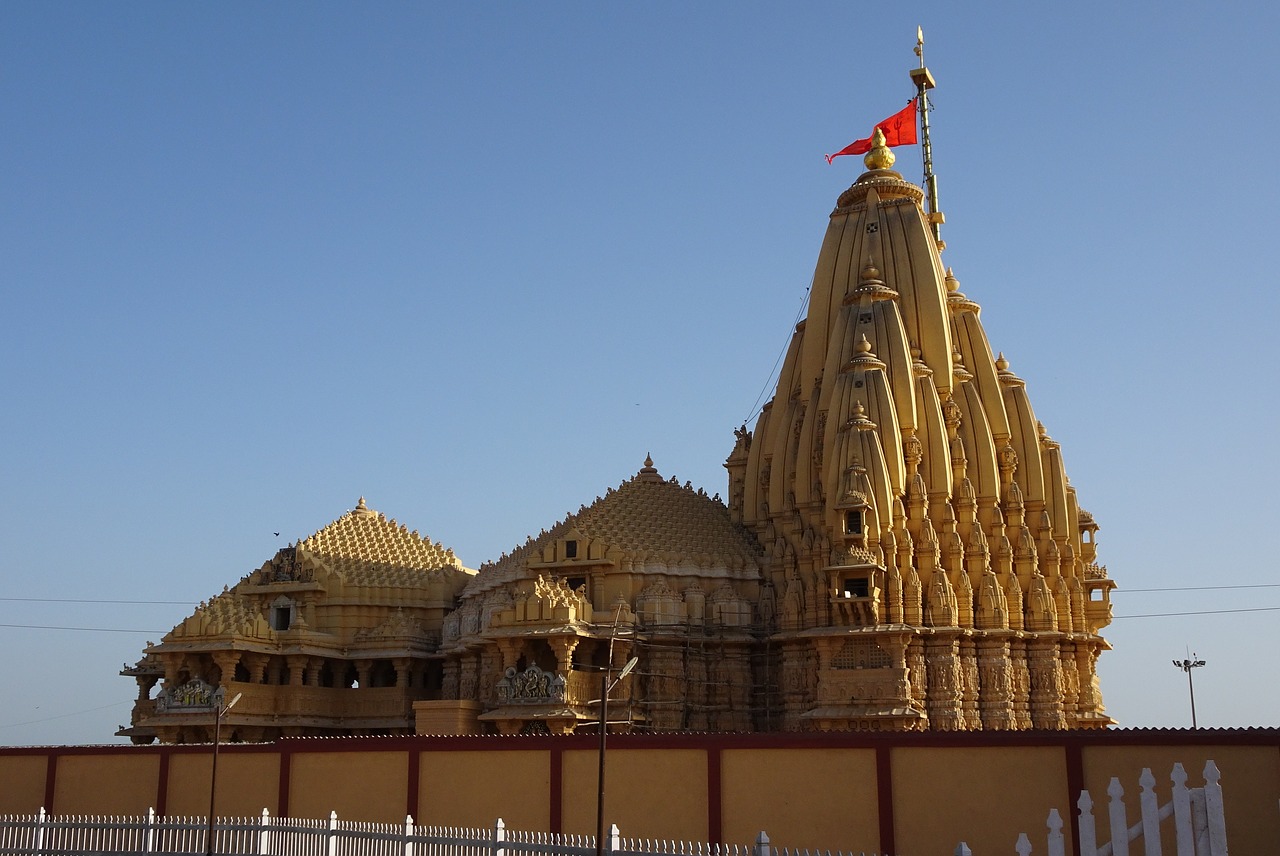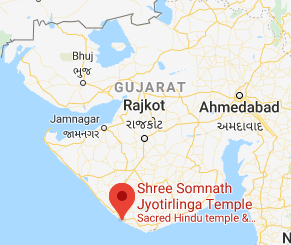The Temple of Somnath

सौराष्ट्रदेशे विशदेऽतिरम्ये ज्योतिर्मयं चन्द्रकलावतंसम् | भक्तप्रदानाय कृपावतीर्णं तं सोमनाथं शरणं प्रपद्ये ‖ 1 ‖
– Meaning
I seek refuge of the Soma Nadha,
Who is in the holy and pretty Sourashtra,
Who is dazzling with light, Who wears the crescent of the moon, Who has come there to give,
The gift of devotion and mercy.
The Somnath Temple is located near Veraval (in Saurashtra region) in the west coast of Gujarat. It is the first Jyotirlinga among the twelve listed by Adi Guru Shankaracharya. The temple is considered sacred due to the various legends connected with it. The temple is known in history for the number of destructions and reconstructions it went through. The site of the temple has been a pilgrimage site since ancient days. It was known as Triveni sangam, a confluence of Three Rivers - Kapila, Hiranya and Saraswati.

The Ancient Hindu texts mention this region as Prabhas Kshetra. There is an interesting story regarding the name and importance of this place. According to the legend, the earliest temple here was built by Chandra Dev (Moon). Chandra had married 27 daughters of Daksha Prajapati, but he was partial to one of them, Rohini. Being jealous, the other queens reported to their father. The father got upset and cursed Chandra that he would lose all his lustre and fade away. To get rid of the curse, Chandra prayed to Lord Shiva at this place for six months. Lord Shiva blessed him and reduced the curse. This incident led to the periodic waning of the moon. Chandra took a dip in the Saraswati river and began to glow. Then he built a beautiful golden temple and put a Glorious Jyotirlinga in it, the first of its kind. Lord Shiva resides here as Som Nath ‘the lord of the moon’. The Moon regained its glow here hence the place came to be known as Prabhas Kshetra.
The temple of Somnath has been enjoying a highly esteemed place in Indian history. It is said that the temple was allotted the produce of about 10,000 villages for its maintenance. The grand temple had visitors from all over the country who donated generously. The treasury overflowed with a vast amount of precious metal and stones, the temple rose to be the richest in the country. The treasure was one main reason for the temple being attacked so many times. Mahmud, the infamous invader from Ghazni attacked Somnath in 1025 AD and looted treasure worth 18 crores. The temple is a witness to the determination of the Hindus. The tales of its riches attracted a series of invasions, but each time the temple was invaded, it was restored to its original glory by devout Hindu worshippers.
The present temple was rebuilt after the independence with the initiative taken by Sardar Vallabh Bhai Patel. The temple, Kailash Mahameru Prasad, is built in Chalukya style of temple architecture and reflects the inherent skills of Sompuras, the master masons of Gujarat. A seven-story structure, it has the shikhar, garbhagriha, a sabha mandap (assembly hall), and a nritya mandap (dance hall). It features an elaborate and extravagant architecture marked with intricate carving, silver doors, an impressive Nandi idol and a central Shivlinga. The flag mast on the pinnacle of the temple stretches to a length of about 37 feet and is changed thrice a day.
The temple was completed in five years (1947-51). It was financed by public donations. It was inaugurated by Dr. Rajendra Prasad, the first President of independent India. The temple was inaugurated on Friday 11May,1951. It was a coincidence that the day Mahmud Ghazni destroyed the temple was also Friday 11May in 1025 AD.
Other than the temple, The region also holds its importance in Krishna stories. It is said that the last rites of Lord Krishna was performed on the Triveni Sangam, i.e. here. There is a place called Bhallaka Teerth ( भल्लका तीर्थ ), This place is where Shri Krishna was injured by an arrow and took his last breath. A deep cave near this place is where Balram, who was an incarnation of Shesh Nag, also went back.
There is a museum that houses artifacts from the ruins of the previous temples and information about the place. The temple is situated at a very extraordinary place . An ancient pillar standing in the temple premises. This pillar known as Baan stambh (arrow pillar) has an inscription in Sanskrit which says that there is not a single piece of land from this point to the south pole. This is a wonderful indicator of ancient Indian wisdom.
Footnote:
Nearest Airport: Diu (50KM)
Nearest Railway: Veraval (6KM)